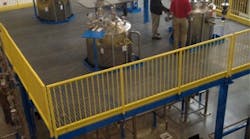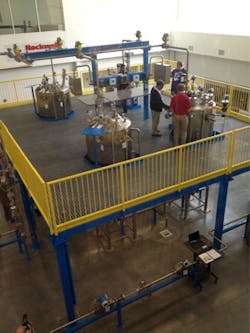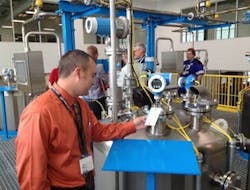Attendees at the Process Solutions Summit visit the PTU in the new Endress+Hauser Customer Center in Greenwood, Indiana.
In the past five years, Endress+Hauser (E+H, www.us.endress.com) will have invested approximately $150 million into its U.S. operations to expand its flow, level, pressure, analytical and temperature manufacturing capabilities, as well as investments in support structures, projects, services and training organizations. This figure doesn’t include expenses related to the recent acquisitions of SpectraSensors and Kaiser Optical Systems, both specialized in advanced analyzer technology. E+H’s customers are faced with an experienced workforce of operators and technicians on the verge of retirement, which translates into a need for training the next generation of employees. Recognizing this void, E+H has built multiple process training units (PTUs) nationwide to address this problem.
In mid-September, E+H inaugurated its 80,000-sq-ft Customer Center, a $16 million infrastructure investment in Greenwood, Indiana, which includes its largest PTU to date, controlled by the PlantPAx system from Rockwell Automation (RA, www.rockwellautomation.com), and multiple classrooms. The opening of the new Customer Center coincided with the Process Solutions Summit, co-hosted by E+H and RA.
“The strengths of Rockwell Automation and Endress+Hauser are complementary,” said Michael Ziesemer, COO at E+H. “It's a revitalization of the relationship between Rockwell Automation and Endress+Hauser. What is new is to be more data-centered and to be able to do something with it. Data analysis and regression analysis — that's what's new and where this is going. The particular challenge is that different disciplines are going to merge. We need a good foundation with mechanical and electrical engineers; plus IT skills and data analysis are skills in themselves. It's definitely clear the curricula are going to change. Progress is where disciplines converge.”
When Google closed on its $3.2 billion acquisition of Nest Labs in February, it strode ardently into the Internet of Things (IoT). “Google knows about the Internet,” said Ziesemer. “But Google does not know about things.” With Nest’s smart-home products, such as its thermostat and carbon monoxide detector and smoke detector, Google now has a stake in the hardware side of the IoT. It’s all about integration — integration between plant and business processes; integration along the lifecycle; software substituting for hardware, and services replacing software; applications in the cloud; mobility; the real world represented in the virtual world; Ethernet to the field in transmitters and valves; Wi-Fi communication; Web server in field devices; big data creating value; integration within value chain; and HMI by smartphones, explained Ziesemer.
“A field device is an IP address at the end of the day. Period,” said Matthias Altendorf, E+H CEO. “The digitalization of the automation world increases in speed. You can have big data, but you have to do something with the big data. When it comes to the future, we measure properties or amounts of matter. We added a lot of engineering capabilities in our sales environments. Our customers focus on their core competencies, which might not be to service a field device, so we can take over that role. We are measured on the performance of our service, and not just the performance of our field device. Engineering is important because we have fewer engineers and fewer field technicians, so we have to ‘automize.’”
Jason Pense, lead technical analyst/instrumentation coordinator at Tyson Foods, checks out the new PTU at Endress+Hauser's Customer Center in Greenwood, Indiana.
Jason Pense, lead technical analyst/instrumentation coordinator at Tyson Foods (www.tyson.com), headquartered in Springdale, Arkansas, explained how he's been using Endress+Hauser and Rockwell Automation. “We're the second largest food production company,” he said. “We have customers in more than 130 countries and more than $40 billion in sales. We have our own in-house controls and automation team. We provide 24/7 support.” Life is good.
About 10 years ago, however, Pense’s group was smaller. “Implementation standards were not in place,” he explained. “Data plates were rubbed off. Documentation was nonexistent at the plant. We’ve had a lot of challenges and struggles. It was difficult to use existing devices, so we needed a change. As the demand for automation grew, we thought it would be a good idea to have a single supplier. Over the next few years, we helped to save Tyson thousands of dollars.”
Tyson now uses ProMag flowmeters and Waterpilot FMX21 in its water/wastewater processes to measure DO, turbidity, and nitrates. It’s using ProMass Coriolis flowmeters for critical liquid dosing and nonconductive liquids in field mills. “On the plant floor, we're using Ethernet I/P and ProMass with Rockwell software,” said Pense. “Tank farms use hydrostatic level combined with Smart/HART Allen-Bradley PLC analog cards, and we’re monitoring water, air, gas, electricity, and steam. We’re also in the investigative stages of using W@M services for asset lifecycle management, and we’re planning to implement it to better control our assets.” Although Tyson is in Springdale, its plants are scattered throughout the country. “A lot of our automation needs come from our water/wastewater plant,” said Pense. “It dumps to a stream or the ocean. We cannot have spills. We have our processes dumping into effluent pits. Food and beverage is one of the harshest environments for instrumentation. There’s an additional cost of putting in additional measurements and monitoring, but our customers are telling us we have to start doing that or it could affect sales.”
The future is much more interesting than the past, emphasized Ziesemer. “The tide has changed," he said. "There is re-industrialization, particularly in the United States. There are two main driving forces — energy and information. Horizontal drilling and shale gas has offset declines in other U.S. supply to meet consumption growth and lower import needs. Cheap energy is one strong long-term driver. The United States is independent from gas imports.”
In 2010, the United States accounted for 24% of the global manufacturing economy, said Ziesemer. China at 16% and Germany at 10% were the only other two countries with a double-digit percentage of the $160 billion world market. That’s a large piece of international production, but 10 years prior, in 2000, the United States was responsible for 40% of the world’s production, and Japan, at 13%, was the only other country in double digits. “The United States still has a leading role, but its importance is shrinking,” explained Ziesemer. “I think it is a result of ‘de-industrialization’ — a political emphasis on services for almost two decades. Industry was considered to be the old economy instead of the new economy. There is no strong economy without strong process industries and a strong manufacturing sector. There are no strong process and manufacturing industries without a strong automation and instrumentation sector.”
Five to 10 years ago, E+H had a handful of products at a typical customer plant site, and the customer expected delivery of high-quality instruments, said Todd Lucey, managing director of E+H Sales Center USA. “But today, the whole plant is full of Endress+Hauser instruments, so expectations are considerably higher on us in terms of our capability to support them and help solve complex customer problems. Frankly, the more complex problems we solve, the more complex problems we get from our customers, which is really the position we want to be in. And we look forward to that challenge.”
E+H has been working with a number of organizations to attract talent, explained Lucey. “Energy, water, the food supply are impacted by process automation. How do we make automation cool? How do we get them to the process automation space instead of working at Google?” he asked. On the E+H PTU, there are 120 points of measurement. “About a year ago, we had seven of these across the United States,” said Lucey. The 10th PTU will be unveiled at George E. Booth’s facility in Romeoville, Illinois, on Sept. 30. “Each one of these is about a $1 million investment to attract and train the talent,” he explained. “It would be difficult to find a career with more meaning than one in process automation. We see from students that the way they learn is by doing. We’ve hired students out of the local universities. These students are doing on-the-job work, and we're mentoring them.”


